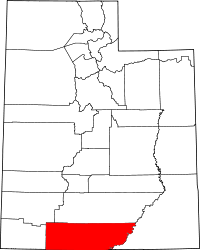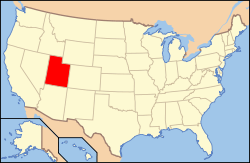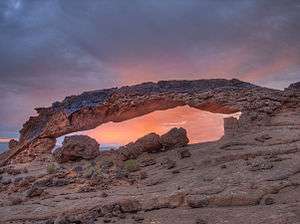Kane County, Utah
| Kane County, Utah | |
|---|---|
 Location in the U.S. state of Utah | |
 Utah's location in the U.S. | |
| Founded | 1864 |
| Named for | Thomas L. Kane |
| Seat | Kanab |
| Largest city | Kanab |
| Area | |
| • Total | 4,109 sq mi (10,642 km2) |
| • Land | 3,990 sq mi (10,334 km2) |
| • Water | 118 sq mi (306 km2), 2.9% |
| Population (est.) | |
| • (2015) | 7,131 |
| • Density | 1.8/sq mi (1/km²) |
| Congressional district | 2nd |
| Time zone | Mountain: UTC-7/-6 |
| Website |
kane |

Kane County is a county located in the U.S. state of Utah. As of the 2010 census, the population was 7,125.[1] Its county seat and largest city is Kanab.[2] The county was named for Col. Thomas L. Kane,[3] a friend of the Mormon settlers.
Geography
According to the U.S. Census Bureau, the county has a total area of 4,109 square miles (10,640 km2), of which 3,990 square miles (10,300 km2) is land and 118 square miles (310 km2) (2.9%) is water.[4] The Colorado River, reformed as Lake Powell, forms its eastern boundary. Arizona lies on the southern boundary. Grand Staircase-Escalante National Monument covers much of the county. A rugged and inhospitable country of deserts, mountains and cliffs makes up the terrain, with breath-taking scenery in every area. Parts of Bryce Canyon National Park and Zion National Park extend into the northern and western portions of the county. The eastern part of the county is part of the Glen Canyon National Recreation Area.
Adjacent counties
- Washington County (west)
- Iron County (northwest)
- Garfield County (north)
- San Juan County (east)
- Mohave County, Arizona (southwest)
- Coconino County, Arizona (south)
National protected areas
- Bryce Canyon National Park (part)
- Dixie National Forest (part)
- Glen Canyon National Recreation Area (part)
- Grand Staircase-Escalante National Monument (part)
- Zion National Park (part)
Utah protected areas
Demographics
| Historical population | |||
|---|---|---|---|
| Census | Pop. | %± | |
| 1870 | 1,513 | — | |
| 1880 | 3,085 | 103.9% | |
| 1890 | 1,685 | −45.4% | |
| 1900 | 1,811 | 7.5% | |
| 1910 | 1,652 | −8.8% | |
| 1920 | 2,054 | 24.3% | |
| 1930 | 2,235 | 8.8% | |
| 1940 | 2,561 | 14.6% | |
| 1950 | 2,299 | −10.2% | |
| 1960 | 2,667 | 16.0% | |
| 1970 | 2,421 | −9.2% | |
| 1980 | 4,024 | 66.2% | |
| 1990 | 5,169 | 28.5% | |
| 2000 | 6,046 | 17.0% | |
| 2010 | 7,125 | 17.8% | |
| Est. 2015 | 7,131 | [5] | 0.1% |
| U.S. Decennial Census[6] 1790–1960[7] 1900–1990[8] 1990–2000[9] 2010–2014[1] | |||
As of the census[10] of 2000, there were 6,046 people, 2,237 households, and 1,628 families residing in the county. The population density was 2 people per square mile (1/km²). There were 3,767 housing units at an average density of 1 per square mile (0/km²). The racial makeup of the county was 96.00% White, 0.03% Black or African American, 1.55% Native American, 0.22% Asian, 0.05% Pacific Islander, 0.74% from other races, and 1.41% from two or more races. 2.32% of the population were Hispanic or Latino of any race. The top 5 ethnic groups in Kane County are:
There were 2,237 households out of which 32.20% had children under the age of 18 living with them, 64.60% were married couples living together, 6.00% had a female householder with no husband present, and 27.20% were non-families. 23.30% of all households were made up of individuals and 10.20% had someone living alone who was 65 years of age or older. The average household size was 2.67 and the average family size was 3.21.
In the county, the population was spread out with 29.40% under the age of 18, 6.80% from 18 to 24, 21.20% from 25 to 44, 25.90% from 45 to 64, and 16.70% who were 65 years of age or older. The median age was 39 years. For every 100 females there were 98.30 males. For every 100 females age 18 and over, there were 94.10 males.
The median income for a household in the county was $34,247, and the median income for a family was $40,030. Males had a median income of $30,655 versus $20,406 for females. The per capita income for the county was $15,455. About 5.50% of families and 7.90% of the population were below the poverty line, including 9.30% of those under age 18 and 5.40% of those age 65 or over.
Politics
The county is one of the most heavily and reliably Republican in the nation. Of "straight-ticket" voters in the 2008 election there were 992 Republicans and 326 Democrats. In the Utah gubernatorial election, 2004 nearly 70% of the county's vote went for Jon Huntsman, Jr. and in the 2008 election he received roughly 75% of the vote. That stated, it is part of Utah's 2nd congressional district and thus was represented by moderate Democrat Jim Matheson for many years, until 2013. The second district is now represented by Republican Chris Stewart, elected in 2012 when Jim Matheson ran for election to the newly created fourth district instead of remaining in the second.
In Presidential elections the county has not been won by a Democratic candidate since Woodrow Wilson in 1916 and was the only county in Utah carried by Alf Landon.[11] It has solidly favored the Republican candidate since at least 1956, when Dwight D. Eisenhower received approximately 90% of the vote.[12][13] In 1964 the county went solidly for Barry Goldwater who lost the state by over 9%.[14] Since 1920, only in the Democratic landslides of 1936, 1940 and 1964 did the Democratic candidate for president receive even 30% of the county's vote.[15]
Communities

City
- Kanab (county seat)
Towns
Unincorporated communities
Ghost town
See also
References
- 1 2 "State & County QuickFacts". United States Census Bureau. Retrieved December 29, 2013.
- ↑ "Find a County". National Association of Counties. Retrieved 2011-06-07.
- ↑ Gannett, Henry (1905). The Origin of Certain Place Names in the United States. Govt. Print. Off. p. 172.
- ↑ "2010 Census Gazetteer Files". United States Census Bureau. August 22, 2012. Retrieved June 25, 2015.
- ↑ "County Totals Dataset: Population, Population Change and Estimated Components of Population Change: April 1, 2010 to July 1, 2015". Retrieved July 2, 2016.
- ↑ "U.S. Decennial Census". United States Census Bureau. Retrieved June 25, 2015.
- ↑ "Historical Census Browser". University of Virginia Library. Retrieved June 25, 2015.
- ↑ Forstall, Richard L., ed. (June 25, 1995). "Population of Counties by Decennial Census: 1900 to 1990". United States Census Bureau. Retrieved March 27, 2015.
- ↑ "Census 2000 PHC-T-4. Ranking Tables for Counties: 1990 and 2000" (PDF). United States Census Bureau. April 2, 2001. Retrieved June 25, 2015.
- ↑ "American FactFinder". United States Census Bureau. Retrieved 2011-05-14.
- ↑ [ Geographie Electorale]
- ↑ [ David Leip Presidential Election Atlas (Statistics for 1956)]
- ↑ [ David Leip's Presidential Election Atlas (Election maps for Utah for post-1956 elections)]
- ↑ [ David Leip's Presidential Election Atlas - 1964 statistics for Utah]
- ↑ CQ Press
External links
 |
Iron County | Garfield County |  | |
| Washington County | |
San Juan County | ||
| ||||
| | ||||
| |
|
Coordinates: 37°17′N 111°53′W / 37.29°N 111.89°W